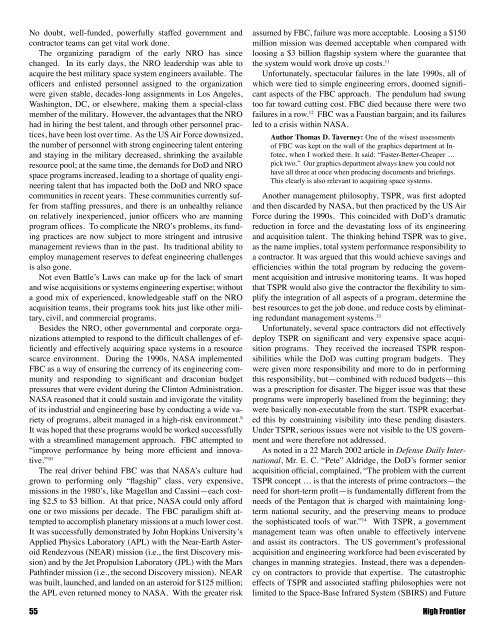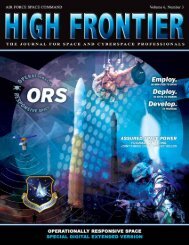Space Acquisition - Air Force Space Command
Space Acquisition - Air Force Space Command
Space Acquisition - Air Force Space Command
You also want an ePaper? Increase the reach of your titles
YUMPU automatically turns print PDFs into web optimized ePapers that Google loves.
No doubt, well-funded, powerfully staffed government and<br />
contractor teams can get vital work done.<br />
The organizing paradigm of the early NRO has since<br />
changed. In its early days, the NRO leadership was able to<br />
acquire the best military space system engineers available. The<br />
officers and enlisted personnel assigned to the organization<br />
were given stable, decades-long assignments in Los Angeles,<br />
Washington, DC, or elsewhere, making them a special-class<br />
member of the military. However, the advantages that the NRO<br />
had in hiring the best talent, and through other personnel practices,<br />
have been lost over time. As the US <strong>Air</strong> <strong>Force</strong> downsized,<br />
the number of personnel with strong engineering talent entering<br />
and staying in the military decreased, shrinking the available<br />
resource pool; at the same time, the demands for DoD and NRO<br />
space programs increased, leading to a shortage of quality engineering<br />
talent that has impacted both the DoD and NRO space<br />
communities in recent years. These communities currently suffer<br />
from staffing pressures, and there is an unhealthy reliance<br />
on relatively inexperienced, junior officers who are manning<br />
program offices. To complicate the NRO’s problems, its funding<br />
practices are now subject to more stringent and intrusive<br />
management reviews than in the past. Its traditional ability to<br />
employ management reserves to defeat engineering challenges<br />
is also gone.<br />
Not even Battle’s Laws can make up for the lack of smart<br />
and wise acquisitions or systems engineering expertise; without<br />
a good mix of experienced, knowledgeable staff on the NRO<br />
acquisition teams, their programs took hits just like other military,<br />
civil, and commercial programs.<br />
Besides the NRO, other governmental and corporate organizations<br />
attempted to respond to the difficult challenges of efficiently<br />
and effectively acquiring space systems in a resource<br />
scarce environment. During the 1990s, NASA implemented<br />
FBC as a way of ensuring the currency of its engineering community<br />
and responding to significant and draconian budget<br />
pressures that were evident during the Clinton Administration.<br />
NASA reasoned that it could sustain and invigorate the vitality<br />
of its industrial and engineering base by conducting a wide variety<br />
of programs, albeit managed in a high-risk environment. 9<br />
It was hoped that these programs would be worked successfully<br />
with a streamlined management approach. FBC attempted to<br />
“improve performance by being more efficient and innovative.”<br />
10<br />
The real driver behind FBC was that NASA’s culture had<br />
grown to performing only “flagship” class, very expensive,<br />
missions in the 1980’s, like Magellan and Cassini—each costing<br />
$2.5 to $3 billion. At that price, NASA could only afford<br />
one or two missions per decade. The FBC paradigm shift attempted<br />
to accomplish planetary missions at a much lower cost.<br />
It was successfully demonstrated by John Hopkins University’s<br />
Applied Physics Laboratory (APL) with the Near-Earth Asteroid<br />
Rendezvous (NEAR) mission (i.e., the first Discovery mission)<br />
and by the Jet Propulsion Laboratory (JPL) with the Mars<br />
Pathfinder mission (i.e., the second Discovery mission). NEAR<br />
was built, launched, and landed on an asteroid for $125 million;<br />
the APL even returned money to NASA. With the greater risk<br />
assumed by FBC, failure was more acceptable. Loosing a $150<br />
million mission was deemed acceptable when compared with<br />
loosing a $3 billion flagship system where the guarantee that<br />
the system would work drove up costs. 11<br />
Unfortunately, spectacular failures in the late 1990s, all of<br />
which were tied to simple engineering errors, doomed significant<br />
aspects of the FBC approach. The pendulum had swung<br />
too far toward cutting cost. FBC died because there were two<br />
failures in a row. 12 FBC was a Faustian bargain; and its failures<br />
led to a crisis within NASA.<br />
Author Thomas D. Taverney: One of the wisest assessments<br />
of FBC was kept on the wall of the graphics department at Infotec,<br />
when I worked there. It said: “Faster-Better-Cheaper …<br />
pick two.” Our graphics department always knew you could not<br />
have all three at once when producing documents and briefings.<br />
This clearly is also relevant to acquiring space systems.<br />
Another management philosophy, TSPR, was first adopted<br />
and then discarded by NASA, but then practiced by the US <strong>Air</strong><br />
<strong>Force</strong> during the 1990s. This coincided with DoD’s dramatic<br />
reduction in force and the devastating loss of its engineering<br />
and acquisition talent. The thinking behind TSPR was to give,<br />
as the name implies, total system performance responsibility to<br />
a contractor. It was argued that this would achieve savings and<br />
efficiencies within the total program by reducing the government<br />
acquisition and intrusive monitoring teams. It was hoped<br />
that TSPR would also give the contractor the flexibility to simplify<br />
the integration of all aspects of a program, determine the<br />
best resources to get the job done, and reduce costs by eliminating<br />
redundant management systems. 13<br />
Unfortunately, several space contractors did not effectively<br />
deploy TSPR on significant and very expensive space acquisition<br />
programs. They received the increased TSPR responsibilities<br />
while the DoD was cutting program budgets. They<br />
were given more responsibility and more to do in performing<br />
this responsibility, but—combined with reduced budgets—this<br />
was a prescription for disaster. The bigger issue was that these<br />
programs were improperly baselined from the beginning; they<br />
were basically non-executable from the start. TSPR exacerbated<br />
this by constraining visibility into these pending disasters.<br />
Under TSPR, serious issues were not visible to the US government<br />
and were therefore not addressed.<br />
As noted in a 22 March 2002 article in Defense Daily International,<br />
Mr. E. C. “Pete” Aldridge, the DoD’s former senior<br />
acquisition official, complained, “The problem with the current<br />
TSPR concept … is that the interests of prime contractors—the<br />
need for short-term profit—is fundamentally different from the<br />
needs of the Pentagon that is charged with maintaining longterm<br />
national security, and the preserving means to produce<br />
the sophisticated tools of war.” 14 With TSPR, a government<br />
management team was often unable to effectively intervene<br />
and assist its contractors. The US government’s professional<br />
acquisition and engineering workforce had been eviscerated by<br />
changes in manning strategies. Instead, there was a dependency<br />
on contractors to provide that expertise. The catastrophic<br />
effects of TSPR and associated staffing philosophies were not<br />
limited to the <strong>Space</strong>-Base Infrared System (SBIRS) and Future<br />
55 High Frontier











